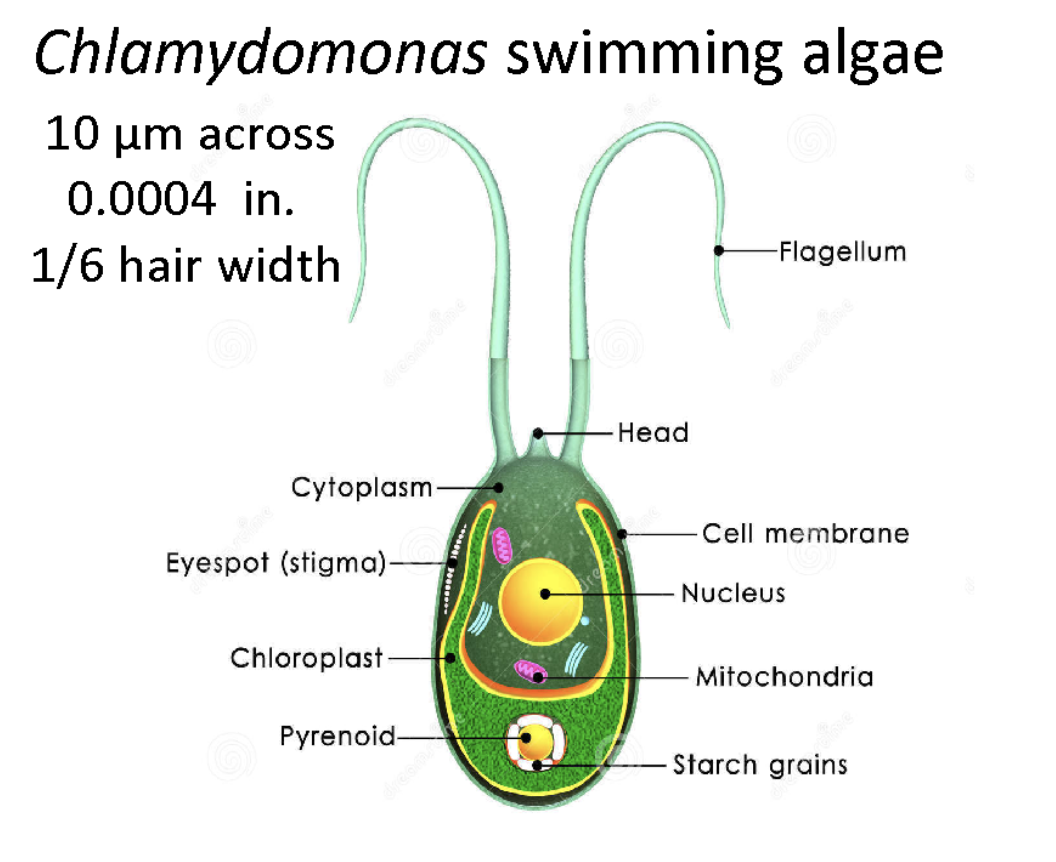The Praiseworthy Green Algae
By David Peters
Philippians 4:8: “if anything is … praiseworthy, think on such things.”
As an engineering professor, I have studied much that is praiseworthy. One of the most extraordinary is the swimming green alga, Chlamydomonas (illustrated above). Due to my interests in structural and fluid mechanics, I have had the privilege of serving on several dissertation committees dealing with the biomechanics of these algae. So why do I deem them praiseworthy?
Algae need light in order to photosynthesize. Chlamydomonas possesses an eyespot that is sensitive to light (the "stigma" seen in the illustration above). Once light is detected, these algae turn and swim toward that light –– propelled by two thread-like structures (flagella) that oscillate rapidly. When the cell is finished feeding, its flagella then move it away from the light.
Alga genetically modified to have only one flagellum.
Wild algae swim too rapidly to be viewed under a microscope. To overcome this limitation, researchers study a genetically modified Chlamydomonas (with only one flagellum), which causes it to swim in circles and stay in view (see the micro-photo above). This isn’t restricting the movement of an animal—Chlamydomonas, after all, is a plant. Not only that, it is a one-celled plant –– so small that six algae can fit within the span of a single human hair.
Chlamydomonas has no brain, no nervous system, and no circulatory system. It has only a nucleus, cytoplasm, a chloroplast (to collect photon energy), a pyrenoid (to make food), and a cell-wall membrane to hold it all in place. Yet a Chlamydomonas –– at a scale of only about 10 microns –– can not only sense light, but propel itself toward the light. How?
The Amazing Propulsion System
Chlamydomonas has two electric motors each of which is connected to the base of a flagellum by means of a 90-degree hook. (See the figure below.) The motors then spin the flagella at rates of over 2000 rotations-per-minute (in a corkscrew motion) to propel the cell through the water. The operation of the rotors is governed by precise signals from the stigma that are transmitted through the cytoplasm. The signals dictate the individual rotation of each flagellum in order to move the alga either in the direction of the light (or away from it).
What we are talking about here is an electric motor. I am not saying that these algae have something that is like an electric motor –– or that they possess merely a primitive imitation of a motor. As a mechanical engineer, I am definitively asserting that these algae have actual, complete, sophisticated, electric motors at the tiniest scale imaginable.
The entire assembly for each motor is only 27 nanometers in length (one millionth of an inch). Yet within that one millionth of an inch there is a stator and a rotor (creating the armature); there is a bushing (with bearings); there is a shaft around which the system rotates (under the power of alternating electromagnetic forces); and there is a control mechanism (driving it all). It is, in the most precise sense of the term, an electric motor.
In a single-celled organism without a nervous system –– without wires, magnets, or an external source of electricity –– how do the elements of the rotor and stator switch on and off so the armature continues to spin, driving each of the flagella? They do so through rotation by the synchronous motion of individual hydrogen ions (i.e., by single protons). The red arrows in the figure below show how the protons travel down to the rotor from the stator –– in continuing rotation –– to drive the motor.
This incredible machine exists on a nanoscale of one millionth of an inch!
How is it Assembled?
How are new green algae formed? The entire structure of each Chlamydomonas is assembled from available amino acids based on instructions found in the DNA contained within the cell's nucleus. The genome of this alga consists of 17 chromosomes that carry 30 megabytes of information in the form of 120 million base-pair rungs –– each made up of two of the proteins: Adenine (A), Guanine (G), Cytosine (C), and Thymine (T). This genetic code carries the information for the formation and assembly of all components of these algae, including their electric motors.
To put this in perspective, Namiki Precision of Japan makes the smallest man-made electric motor, which is 0.6 mm across. About ten billion flagellar motors could fit in the volume of a Namiki motor. The Guinness Book of World Records lists the smallest pseudo electric motor (which spins due to electromagnetic forces but is unable to drive an external device) as 200 nanometers across. This tiny pseudo motor occupies the volume of 1,000 flagellar motors of Chlamydomonas.
These tiniest motors ever designed by humans cannot search for a source of electricity, propel themselves over to that source, plug themselves in, and then unplug themselves to leave after they are fully charged. Furthermore, no one in their wildest dreams would imagine that any humanly-designed machine of microscale or nanoscale, if given a supply of component parts, could then assemble copies of itself from those parts.
The swimming green algae, Chlamydomonas, does all of this –– and does it autonomously. God manufactured the smallest electric motor on the planet before human beings even existed, in ways human beings cannot begin to match, and gave that motor to a one-celled plant in order to propel it to the light.
The design and function of the amazing, swimming green algae, Chlamydomonas, is truly praiseworthy! Soli Deo Gloria!
David A. Peters is the McDonnell Douglas Professor of Engineering and a Carver Project Faculty Fellow.




